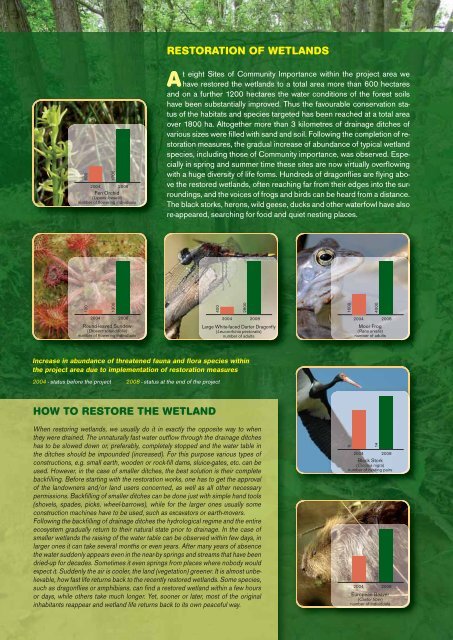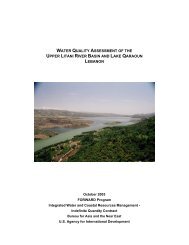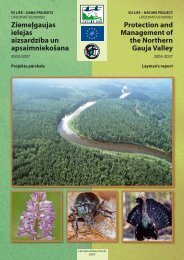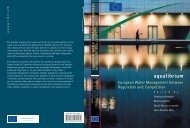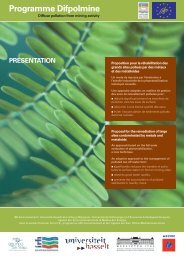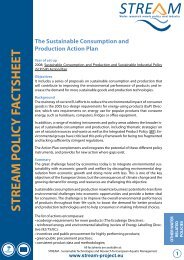RESTORATION OF WETLANDS At - wise-rtd.info
RESTORATION OF WETLANDS At - wise-rtd.info
RESTORATION OF WETLANDS At - wise-rtd.info
Create successful ePaper yourself
Turn your PDF publications into a flip-book with our unique Google optimized e-Paper software.
600<br />
1700<br />
2004 2008<br />
Fen Orchid<br />
(Liparis loeselii)<br />
number of flowering individuals<br />
<strong>RESTORATION</strong> <strong>OF</strong> <strong>WETLANDS</strong><br />
<strong>At</strong> eight Sites of Community Importance within the project area we<br />
have restored the wetlands to a total area more than 600 hectares<br />
and on a further 1200 hectares the water conditions of the forest soils<br />
have been substantially improved. Thus the favourable conservation status<br />
of the habitats and species targeted has been reached at a total area<br />
over 1800 ha. Altogether more than 3 kilometres of drainage ditches of<br />
various sizes were filled with sand and soil. Following the completion of restoration<br />
measures, the gradual increase of abundance of typical wetland<br />
species, including those of Community importance, was observed. Especially<br />
in spring and summer time these sites are now virtually overflowing<br />
with a huge diversity of life forms. Hundreds of dragonflies are flying above<br />
the restored wetlands, often reaching far from their edges into the surroundings,<br />
and the voices of frogs and birds can be heard from a distance.<br />
The black storks, herons, wild geese, ducks and other waterfowl have also<br />
re-appeared, searching for food and quiet nesting places.<br />
120<br />
1300<br />
400<br />
2800<br />
1600<br />
4000<br />
2004 2008<br />
Round-leaved Sundew<br />
(Drosera rotundifolia)<br />
number of flowering individuals<br />
2004 2008<br />
Large White-faced Darter Dragonfly<br />
(Leucorrhinia pectoralis)<br />
number of adults<br />
2004 2008<br />
Moor Frog<br />
(Rana arvalis)<br />
number of adults<br />
Increase in abundance of threatened fauna and flora species within<br />
the project area due to implementation of restoration measures<br />
2004 - status before the project 2008 - status at the end of the project<br />
HOW TO RESTORE THE WETLAND<br />
When restoring wetlands, we usually do it in exactly the opposite way to when<br />
they were drained. The unnaturally fast water outflow through the drainage ditches<br />
has to be slowed down or, preferably, completely stopped and the water table in<br />
the ditches should be impounded (increased). For this purpose various types of<br />
constructions, e.g. small earth, wooden or rock-fill dams, sluice-gates, etc. can be<br />
used. However, in the case of smaller ditches, the best solution is their complete<br />
backfilling. Before starting with the restoration works, one has to get the approval<br />
of the landowners and/or land users concerned, as well as all other necessary<br />
permissions. Backfilling of smaller ditches can be done just with simple hand tools<br />
(shovels, spades, picks, wheel-barrows), while for the larger ones usually some<br />
construction machines have to be used, such as excavators or earth-movers.<br />
Following the backfilling of drainage ditches the hydrological regime and the entire<br />
ecosystem gradually return to their natural state prior to drainage. In the case of<br />
smaller wetlands the raising of the water table can be observed within few days, in<br />
larger ones it can take several months or even years. After many years of absence<br />
the water suddenly appears even in the near-by springs and streams that have been<br />
dried-up for decades. Sometimes it even springs from places where nobody would<br />
expect it. Suddenly the air is cooler, the land (vegetation) greener. It is almost unbelievable,<br />
how fast life returns back to the recently restored wetlands. Some species,<br />
such as dragonflies or amphibians, can find a restored wetland within a few hours<br />
or days, while others take much longer. Yet, sooner or later, most of the original<br />
inhabitants reappear and wetland life returns back to its own peaceful way.<br />
9<br />
14<br />
2004 2008<br />
Black Stork<br />
(Ciconia nigra)<br />
number of nesting pairs<br />
60<br />
120<br />
2004 2008<br />
European Beaver<br />
(Castor fiber)<br />
number of individuals


